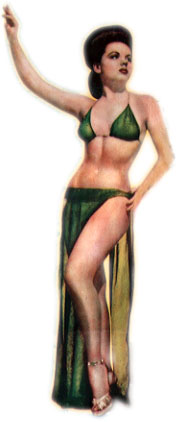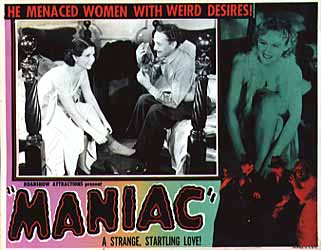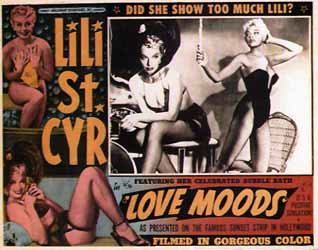|
 From the 1920s through the 1970s, America's most fearless entrepreneurs created thousands of "adults only" features--exploitation films that promised "Sinsational!" treatments of the day's hottest topics. These films played red-light-district theaters and roadshows for almost half a century, until hardcore pornography and the advent of VCRs rang the death knell for this distinctive form of "art." From the 1920s through the 1970s, America's most fearless entrepreneurs created thousands of "adults only" features--exploitation films that promised "Sinsational!" treatments of the day's hottest topics. These films played red-light-district theaters and roadshows for almost half a century, until hardcore pornography and the advent of VCRs rang the death knell for this distinctive form of "art."
This world of sexploitation cinema is investigated in new book by Eddie Muller and Daniel Faris called Grindhouse. This book takes its readers on a journey through the history of "Adults Only" movies as played out in the grindhouse circuit. Starting with the sex hygiene and vice racket pictures of the thirties and continuing through the burlesque films of the forties, the nudist camp and nudie cutie movies of the fifties, and the roughies, kinkies and ghoulies of the sixties, Muller and Faris paint a picture of the sexual attitudes of the times and the hucksters who teased their audiences with promises of forbidden sights.
Recently I had the privilege of talking to Eddie Muller about the history of grindhouse cinema.
Images: Few people have written about the films that you cover in this book. Do you see yourself as an explorer in uncharted territory?
Eddie Muller: Absolutely, I like to think of it as cultural archaeology. Specifically, the genesis of the book was with the art because years ago a friend of mine, who was a projectionist in San Francisco, called me up and said he had discovered in a dumpster behind an old movie theater a lot of this material. And he said you won't believe this stuff. So when I say it's cultural archaeology, it really is: you climb in the dumpster and you excavate. I had this material for a long time, and then I tried to figure out what I could do with it. And I started seeing the novelty postcard books appear--old movie posters, lobby cards, and stuff like that--but I hadn't seen anybody do anything with specifically these "Adults Only" movies; so I got together with Dan Faris in San Francisco, whom I knew many years ago. He was the first person in San Francisco that was marketing old movie ephemera--posters and stills and lobby cards--that was way back in 1967. That was pretty uncharted territory then. So I looked him up because I was trying to get some information on specific films and Dan was able to give me a lot of info. He said he had a lot of material from the fifties and sixties, and we kind of pooled our collections; we had that all laid out, and I said, "Wow. This is the complete visual story line--how we got from the midway carnival tent to Behind the Green Door." There it was. All in pictures. And we said, this is no longer a souvenir novelty book. This is the whole history of "Adults Only" cinema.
|

Dwain Esper's Maniac (1934) features a smorgasboard of debauchery, including rape, fleeting nudity, women catfighting, and a bizarre scene where a doctor gouges out a cat's eye and eats it!
|
Images: Do you claim any archeological importance for the material or is it primarily a fascination with the material and a desire to spread the word?
Eddie Muller: It's both actually. Unlike a lot of people who have considered this material before me, who've come from the perspective of "Is it obscene?" "Is it good or bad?"--its effect on the culture--my attitude is to not take that approach right up front. So I got into this and did the research without an ax to grind or a particular attitude to express. What I knew was this material exerted an incredible fascination. As I got further into it, I wanted to explore this and see who are the people who made these movies and what is the fascination with this stuff. And then my attitude started to develop. So I would say in a nutshell the book is about the business of voyeurism. Right up front in the introduction, I say in truth this book is more about money than it is about sex--in spite of all the pictures. It really is about money. As I did the research, I developed the notion that "Adults Only" movies are part of this great American carnival. There is that element of hucksterism: I'm fascinated by the notion of the ticket taker, this archetypal being, who is ready to sell anything that is forbidden to people because he knows there is a demand for it. "Ladies and gentlemen, step right up and behind this curtain are things you have never imagined, sights you have never seen and will never forget." That's what this stuff is all about. Now whether that is good or bad depends on the person and what they want to get out of it. That's a fascinating part of the story, the dynamic that existed between the self-appointed social watchdogs ("These are not things we can have in our society.") and these cowboys, such as the Forty Thieves, who were saying "How dare you say we can't look at this stuff. You're creating a market for it just by saying you can't look at it. Thanks for doing our job for us."
Images: Tell me about the Forty Thieves. Who were they?
Eddie Muller: The Forty Thieves was a loosely affiliated cadre of roadshowmen, Their roots were really in traveling carnivals all around the country but particularly in the Midwest and South, what they commonly called the Sucker Belt. They got into the movie business--almost to a man--after Hollywood instituted its own production code, generally known as the Hays code, which stipulated that these are things that Hollywood movies will not show. A lot of the old films were not tame, but when they clamped down and put Will Hays in charge of the Production Code Administration office, he said you can't show nakedness, you can't show vice, you can't show drinking, you can't show gambling, Crime must always be punished and this became the law in Hollywood. The Forty Thieves were filmmakers who were completely outside the jurisdiction of the PCA. They did not work within the Hollywood studio system, and they basically said, "This is great. Hollywood has just created a whole market for us. We'll just make the movies that show all the stuff that they won't show." That's how it began. The only thing that was really a prerequisite was that they have this cloak of morality around what they were doing, so it was a lesson for all. This is what awaits the farm girl who goes to the big city and mixes with the wrong crowd. This is the fate worse than death that awaits her. So you got vice racket pictures which always focused on women falling into prostitution. Sex hygiene movies that talked all about what would happen if a man of good standing succumbed to the temptation of a woman of lower social standing. He'd get a venereal disease. Utter social chaos.
|

Love Moods (1952) features Lili St. Cyr in her celebrated bubble bath routine.
|
Images: Burlesque movies of the forties would leave behind the morality issues and give us women to ogle. How did we get from the morality stories of the thirties to burlesque movies in the forties?
Eddie Muller: Cheesecake became very, very popular during WWII and it became acceptable. After the horrible strain of the war, it was acceptable for men to view women in that way. There was a certain affection placed on it. It was down right patriotic. They had women painted on the noses of fighter planes and every GI had his favorite pin-up girl. So the whole attitude changed. The women who were the stars of burlesque were not in any way considered damsels in distress, which was really the only female character in "Adults Only" movies of the thirties--fallen women. With burlesque that was right out the window. In a nutshell, they were presented as goddesses. And they were not embarrassed by what they were doing. So this was the first time that women were allowed to be sexually expressive.
page 1 of 3

Photo credits: All photos are courtesy of the collections of Eddie Muller and Daniel Faris.
|